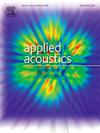复合材料层合结构水声辐射的实验验证计算方法
IF 3.4
2区 物理与天体物理
Q1 ACOUSTICS
引用次数: 0
摘要
提高水下航行器典型复合材料结构部件的声辐射性能对于降低声探测风险和提高低噪声能力至关重要。本文对复合材料层合结构的声辐射特性进行了深入的探讨,并介绍了一种基于三维声弹性理论的数值模拟方法。采用计算与实验相结合的方法对复合材料层合板的水声辐射进行了分析和评价。首先,采用有限元方法对典型层合板进行了动力学建模和模态分析。通过用壳单元定义各层的铺层角对复合材料板进行建模,得到了复合材料板的固有频率和振型,计算精度和效率均较好。随后,我们使用三维声弹性分析软件THAFTS-Acoustic对声辐射特性进行了详细的分析。为了形成湿单元的封闭表面,本方法提出了一个长方体盒子来模拟湿表面。对复合材料圆柱壳的计算结果表明,本文方法与参考解吻合较好。最后,将复合材料层合板的水声辐射实验结果与数值模拟数据进行了比较。在20 ~ 420 Hz范围内,计算声压级曲线与实验声压级曲线基本一致,各测点最大声压级与总声压级的差异在3 dB以内。这进一步验证了所提出的数值方法。综上所述,本文提出了典型复合材料结构声辐射的数值计算方法,为海洋工程装备新型复合材料的低噪声设计提供了科学依据。本文章由计算机程序翻译,如有差异,请以英文原文为准。
Calculation method with experimental validation of underwater acoustic radiation of composite laminate structures
Enhancing the acoustic radiation performance of typical composite structural parts of underwater vehicles is crucial for reducing the risk of acoustic detection and improving low-noise capabilities. This paper conducts an in-depth exploration of the acoustic radiation characteristics of composite laminate structures and introduces a numerical simulation method based on the three-dimensional (3D) sonoelasticity theory. The study analyzes and evaluates the underwater acoustic radiation of composite laminates by combining calculation method and experimentation. First, we use finite element method (FEM) to perform dynamic modeling and modal analysis of the typical laminates. The composite plate is modeled by defining the ply angle of each layer with shell elements, in order to obtain their natural frequencies and vibration modes with satisfactory calculation accuracy and efficiency. Subsequently, we use the 3D sonoelastic analysis software THAFTS-Acoustic to perform a detailed analysis of the acoustic radiation characteristics. To form a closed surface of the wet elements, a cuboid box is proposed to model the wet surface in present method. The results for the composite cylindrical shell demonstrate the good agreement of present method with the reference solution. Lastly, this paper compares the experimental results of underwater acoustic radiation of composite laminates with numerical simulation data. The calculated and experimental sound pressure level (SPL) curves are consistent in the 20–420 Hz, with differences of maximum and total SPL at each measuring point within 3 dB. This further validates the proposed numerical method. In summary, the paper proposes a numerical method for the acoustic radiation of typical composite structures, providing a scientific basis for the low-noise design of new composite materials in marine engineering equipment.
求助全文
通过发布文献求助,成功后即可免费获取论文全文。
去求助
来源期刊

Applied Acoustics
物理-声学
CiteScore
7.40
自引率
11.80%
发文量
618
审稿时长
7.5 months
期刊介绍:
Since its launch in 1968, Applied Acoustics has been publishing high quality research papers providing state-of-the-art coverage of research findings for engineers and scientists involved in applications of acoustics in the widest sense.
Applied Acoustics looks not only at recent developments in the understanding of acoustics but also at ways of exploiting that understanding. The Journal aims to encourage the exchange of practical experience through publication and in so doing creates a fund of technological information that can be used for solving related problems. The presentation of information in graphical or tabular form is especially encouraged. If a report of a mathematical development is a necessary part of a paper it is important to ensure that it is there only as an integral part of a practical solution to a problem and is supported by data. Applied Acoustics encourages the exchange of practical experience in the following ways: • Complete Papers • Short Technical Notes • Review Articles; and thereby provides a wealth of technological information that can be used to solve related problems.
Manuscripts that address all fields of applications of acoustics ranging from medicine and NDT to the environment and buildings are welcome.
 求助内容:
求助内容: 应助结果提醒方式:
应助结果提醒方式:


